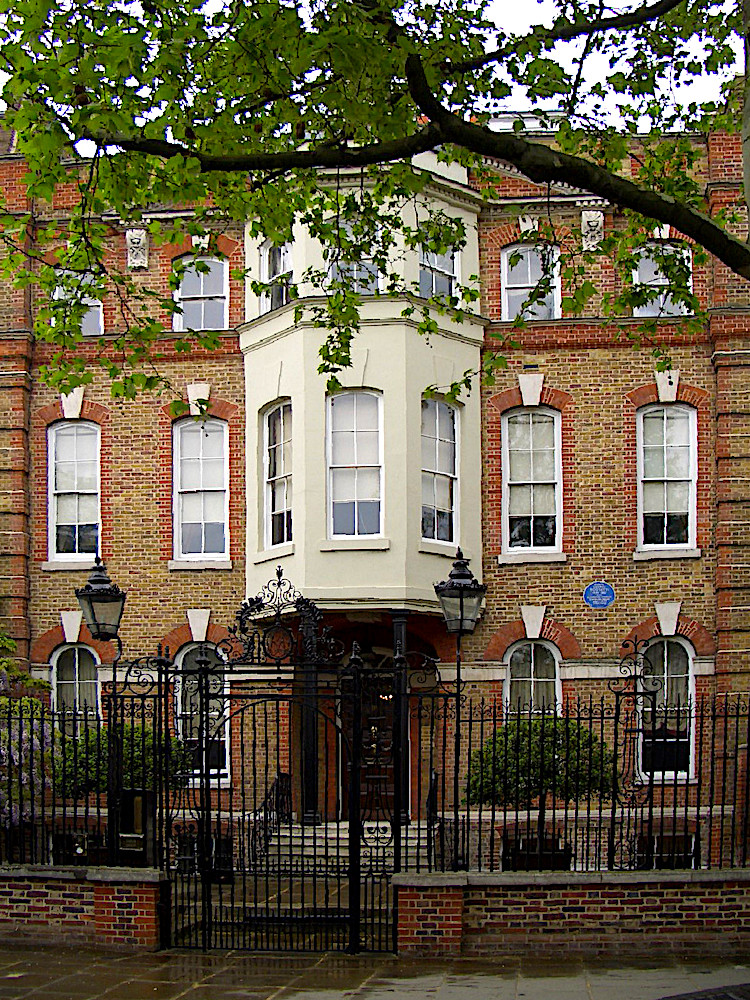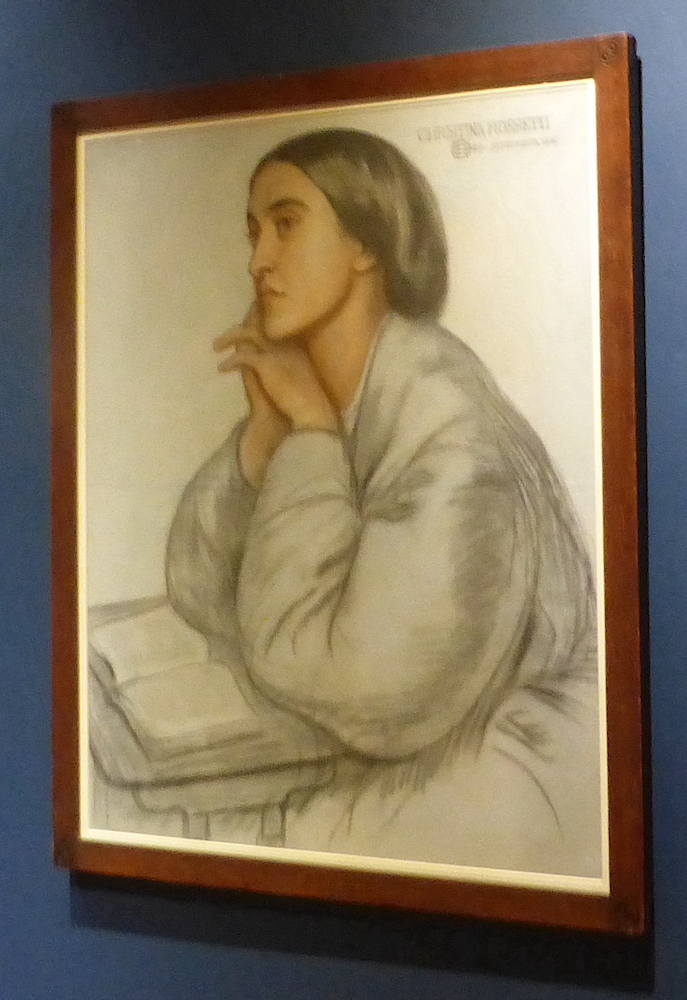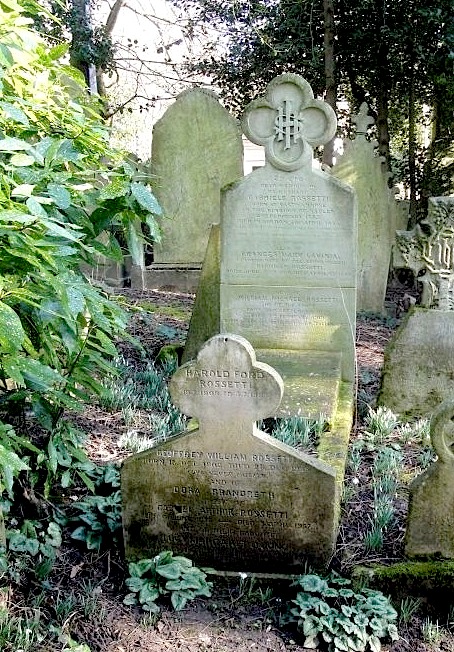All the illustrations here come from our own website, except for the last, which was originally posted on the Geograph website, and can be reproduced on the Creative Commons licence, with attribution. Click on all the images to enlarge them, and (except for the last one) for more information about them, — Jacaqueline Banerjee
Early contacts: 1862-78

he earliest meeting between Christina Rossetti and Lewis Carroll took place in London, in May 1862, in a Rossetti family setting with the visitor then aged thirty, and is discussed in relation to Carroll's little-known Romantic poem Stolen Waters. Miss Rossetti was some two years older than Lewis Carroll, as was Carroll's own spinster sister Elizabeth Lucy, and this may be just one among several factors which secured their lengthy relationship, which was always warm yet impeccably courteous. Carroll's early poetic responsiveness to Christina Rossetti's verses was also fundamental to their respect for each other: he made references to Goblin Market and Other Poems in his private journal in the middle of 1862 (Diaries 4: 66), and echoed her imagery and diction in his own poetry. Carroll's visit to the Rossetti family in October 1863 resulted in his earliest photos of the artist and his family.


Two of Lewis Carroll's photographs from 1863. Left: The Rossetti family together, Right: Dante Gabriel Rossetti.
In October 1864 the name "Miss C. Rossetti" appeared on a list of recipients of copies of Alice's Adventures in Wonderland, which Carroll had added to his journal (Diaries 5: 24). In early 1866 Carroll received a letter from her brother, Dante Gabriel Rossetti, dated 2 February, complimenting him on the book, which, he said, "I saw … at my sister's" (MS Harcourt Amory Collection, Harvard). Rossetti further recommended to Carroll his sister's own "capital fairy tale" which had recently appeared in No. II of the Argosy (Diaries 5: 130-31 n.209). On Friday 29 June that year, Lewis Carroll "Called on the Rossettis," seeing William Rossetti and his wife, but not "the two Misses Rossetti," who were out. In April 1867, in a letter to a Mr. James Leathart, Carroll mentioned enclosing "the photograph of Miss Rossetti" (Diaries 5: 162, 227 n.362 — citing the MS Lindseth Collection). Mention of the Rossettis is then rare or even absent over the following decade, but around July 1875, possibly whilst in Hampstead to photograph some friends of artist-illustrator Henry Holiday, Carroll took a photograph of fifteen-year-old Rose Lawrie draped in a white sheet. This appeared in the album "The Birthday Wreath" named after Christina Rossetti's poem, "The Birthday," together with the quotation "Because the birthday of my life, Is come, my love is come to me" (Diaries 6: 406 n.667).
On Monday 29 July 1878 Carroll was "in town" to see the Royal Academy, and also "called on Miss Christina Rossetti (out)…" (Diaries 7: 127). His fluctuating movements around the London Rossettis during the period 1865-75 may usefully be compared with his more fully documented movements around Alfred Tennyson [coming shortly].
Regular correspondence: 1882-94

16, Cheyne Walk today.
Carroll and Christina Rossetti began to correspond regularly from around November 1882, only after the recent death of Dante Gabriel Rossetti. Carroll, in his regular persona as Christ Church, Oxford academic and amateur photographer Mr. Dodgson, had secured Mrs. Rossetti and Her Children as sitters for his new hobby as early as October 1863, when he became an occasional frequenter of the new Rossetti family residence at Tudor House, 16 Cheyne Walk, Chelsea. Now in late 1882 Carroll posted five prints of the departed brother to the grieving family, and included the promise to deliver personally the historic but fragile glass negative. Christina Rossetti replied to "Dear Mr. Dodgson" (undated, but around early November), grateful for his "unthought-of-kindness" and his "precious gift," which laid her family - what remained of it, she added - "under obligation to you" (Diaries 7: 492-3 & n.803). The poetess, famous in her own right, closed by noting that her mother united with her "in friendly remembrances," and she then signed herself "Christina G. Rossetti" beneath a "Very truly yours." On Saturday 11 November 1882 Carroll duly and early left Oxford - "To town at 9" - and called on "Miss Rossetti" with his precious remembrance, seeing also her mother and aunt. The part-reverential tone and mutual civility would persist throughout their continuing exchanges, a somewhat sharp contrast with Carroll's mid-relationship treatment of his other living poet-idol Tennyson.

Bishop Wilberforce, one of Carroll's
stern "father-figures."
The psychological dynamics of that difference would seem to have lain in other areas of his life: whereas Carroll had no perceptible conflicts and "issues" with his adored sisters (and mother), the opposite was true of his several and often difficult relationships with powerful Augustan father-figures - his own paternal Archdeacon Dodgson, to whom could be added Dean Liddell, Bishop Wilberforce and Dr. Edward Pusey at Christ Church, and possibly others later, even if less fearsome: the newly appointed Cardinal John Newman for example, whom Carroll was careful to avoid and declined to photograph, when invited to do so at Trinity College, Oxford in May 1880 (Diaries 7: 272).
As for the provenance of these later letters, the modern editor of Lewis Carroll's journal, Edward Wakeling, has noted (Diaries 7: 5-6) that further relevant letters became public after the appearance of the two volumes of The Letters of Lewis Carroll edited by Cohen & Green (1979). Some of these, including the Christina Rossetti correspondence of the period under consideration here, are part of the Dodgson Family Collection at the Surrey History Centre, Woking. For convenience and consistency, these are cited below from Wakeling's exhaustive ten-volume edition of the diaries, where the letters are included as extensive footnotes to the closest appropriate journal entries. As several of Christina's letters are incompletely dated, reliance is necessarily placed on Wakeling's carefully researched best guesses. Other letters from more recently discovered correspondence have become part of the Morris L. Parish Collection at Princeton University Library, New Jersey, and these are cited below, at the appropriate places, as "MS Princeton." There may well be more letters, as yet undiscovered: Carroll was a most prolific letter writer, with an estimated correspondence rate even in old age of "about 2000" letters a year (Cohen & Green II: 1031; Letter to Mary Brown, August 1894). He had kept a careful "Letter-Register" all his adult life, the terminal entry being no. 98,721 (Diaries 4: 44-45). The register - filling many notebooks - is not known to have survived, probably owing to the haste with which his family cleared his rooms at Christ Church on his death. Moreover, Carroll himself was not averse to disposing of accumulated old materials: on the weekend of 7-8 August 1875, he noted in his journal, "Another week" gone "exactly like the last" - in new registering (of photographs etc.) and in "going through and destroying old letters" (Diaries 6: 408). However, the following is a record of the correspondence pooled from the sources currently available.

Rossetti's portrait of his sister (1866) on show
at the "Christina Rossetti: Vision and Verse"
exhibition at the Watts Gallery, Compton,
November 2018-March 2019.
1882. November 17. Carroll, as "Dear Mr. Dodgson," received this further and brief letter from Christina Rossetti thanking him for "the famous ghost story which has interested us all." Her further comments on ghostly phenomena, with an apposite comparison of ghosts and photographs, led her to draw once more upon the memory of her departed brother. She signed herself as before, "Very sincerely yours," followed formally by her full name (Diaries7: 492-3, n.803).
1883. Letter (undated) early January. On Saturday January 6 Lewis Carroll took the train to London to visit the Royal Academy at Burlington House, with Amy Walters (b. 1855), a family friend from Guildford whom he had arranged to meet at Waterloo Station. His intention was to show her the posthumous exhibition of "Rossetti's pictures," and he made a particularly favourable comment on the painting Found (Diaries 7: 505). Prior to his visit to the R. A. he had received an undated letter from Christina Rossetti, in which she noted her own "third visit to the R. A. today," when she had "gazed with renewed admiration at Found" (Diaries 505-6 & n.824). Her main motivation in writing appears here to have been to send Carroll an admission coupon to the Burlington Fine Arts Club in order for him to see "the considerable collection of my brother's works" on view there also. She signed herself "Truly your obliged," with her full name as was customary. [See 15 January below with Carroll's acceptance of the social formality. Such could well have occurred earlier, in lost or missing correspondence].

Dante Gabriel Rossetti's painting, Found (unfinished
at the time of his death in 1882).
1883. January 11. Returning from Brighton to Victoria Station, London with his lifetime friend Theo Heaphy (1858-1920), Carroll takes her to see "Rossetti's pictures" at the Royal Academy (Diaries 7: 511).
1883. January 15. Carroll, as "C. L. Dodgson," wrote to Christina granting her and her family full rights to the sale of further copies of the photograph of her brother, which he had delivered to her as the original glass "wet-plate" in November 1882. His letter closed with the formal signature, as noted (Diaries 7: 506-7, citing MS Princeton).
1883. Letter incompletely dated: 17 1883, possibly January. Christina takes pains to reassure "Dear Mr. Dodgson" about his use of the entry coupon to the Burlington Fine Arts Club exhibition, even if he does take "the two ladies under your escort." She makes reference to "the great 'Dante' picture," and notes that the collection displays over 150 items, though many "only small" Diaries 7: 507).
1883. Saturday 20 January. Accompanied by his lifetime friend Ethel Arnold (1866-1930), Carroll visits the Rossetti picture collection at the Burlington Club, noting that his entry was by courtesy of "Miss Rossetti" (513).
1883. Letter undated, probably March 1883. In a very brief note and as "post-time" approached, Christina sent "by rail" a parcel containing an unspecified photograph from her own collection. As is often the case, prior correspondence between the two can be presumed.

Plaque outside 30 Torrington Square, Bloomsbury, to which
Christina and her mother had moved in 1876, and where
Carroll would have been calling on her.
© Christine Matthews.
1883. Friday 16 March. In London, Carroll again takes Theo Heaphy [an art student and the daughter of an artist] about with him, this time "to call with me on Miss Rossetti and on the Humphrey Wards" — Mary Humphrey Ward and her husband (Diaries 7: 523).
1883. 1 December (MS Princeton). "Mr Dodgson" received a letter which was a playful attempt to secure his vote in an upcoming election for a "Miss Young whose card I enclose." Christina notes that his name appears with "five more of the same" [possibly Dodgson sisters/nieces etc ] on a Subscribers List, and then admits to her own "suggestive remark of which the drift is obvious!" (Diaries 8: 67 n.107). The letter closes with "Very sincerely yours," above her formal name as before.
1885. On Friday 15 May, Carroll was in London and "Called on Miss Christina Rossetti," seeing her, the mother and an aunt (Diaries 8: 197-198).
1885. Saturday 27 June. In London with friends to visit the Royal Academy, Carroll calls twice on "Miss Rossetti," who was first "out" and then "in this time" (Diaries 216).
1885. 3 July. Carroll received a letter, undated but located in a correspondence-register number associated with the date given. Miss Rossetti thanked him for the "sweet and pure little poems" which he had sent, and which have been identified as hymns from the hand of Carroll's young child-friend, May Mileham (b. 1874) (Diaries 198 n.336. MS Princeton).
1886. Saturday 12 June. In London to do the rounds with actress and child-friends, and to see the Mikado for the second time that month, Carroll called on "Miss Rossetti (whose mother died about two months ago)" ( 282). His calling by the Rossetti house was later repeated, with grown-up child-friend Edith Rix (b.1866), on Thursday 4 November (Diaries 8: 304).
1892. Wednesday 20 April Lewis Carroll was in London with his younger sister Louisa, when they "called on Miss Christina Rossetti," who was out (Diaries8: 612).
1892. Monday 5 September. Returning from Guildford to his Eastbourne summer-vacation lodgings via London with Edith Rix, Carroll called on a number of friends and social acquaintances including "Miss Christina Rossetti" who unfortunately was "too ill to see any one." His additional knowledge, detailing that "the heart is affected, and she has to be kept perfectly quiet," suggests his concern for, and familiarity with, her situation over an extended period of time (Diaries 9: 27-8).
1893. Letter of [Monday] 9 October 1893 (MS Princeton). Christina Rossetti wrote to "Dear Mr. Dodgson" with her last known communication to him. Apparently Carroll had written to her suggesting that he call to see her on the next Saturday, and her reply begged him to "Please do me that favour and pleasure" if it was possible. She touched upon her currently improved health - said she was "well enough" - and assured him that whether accompanied or unaccompanied he was welcome. A certain "Miss Dodgson" would be "specially welcome," though it is not clear which of Carroll's numerous younger sisters and nieces was meant here.. She continued to sign herself "Christina G. Rossetti," this time beneath "Sincerely yours." (Diaries 9: 99-100 n.180)
1893. Saturday 14 October. Carroll left Oxford early in the morning, "To town by the 8.30," and called first at his friends the Moberly Bells in order to do sketching, led by illustrator E. Gertrude Thomson, with the wife of the Times journalist Charles Frederic Moberly Bell, and her younger daughters Cynthia (b. 1887) and Iris (b. 1883). Carroll adds in his journal. "Then I made… hasty calls, on Miss Rossetti…" with Iris as his "companion" (Diaries 9: 99-100).
1893. Letter of 13 December. Concerning the forthcoming presentation copies of Sylvie and Bruno Concluded. The letter was published along with a very few earlier ones in Cohen & Green I: 464, 482; II: 1000 the letter of 1893). One of the copies would be for Christina Rossetti.
1893. Wednesday 27 December. Carroll was in London at his publisher Macmillan for "some hours" to inscribe presentation copies of the newly available Sylvie and Bruno Concluded. The lengthy list of names indeed includes "Christina G. Rossetti" (Diaries 9: 117 n,202, together with the information that Christina's inscribed copy is now at the Pierpoint Morgan Library, New York).
Unaccountably, the entry above - the final known mention of Christina Rossetti - is not recorded in the Index to Lewis Carroll's Diaries (9: 401 ) under "Rossetti, Christina Georgina," nor does it appear in the larger collected Index, Lewis Carroll's Diaries. Complete Index (10: 299) under her name. Entries there to Christina Rossetti unaccountably end with volume 8, omitting entirely the references to her in volume 9, which covers the sensitive period from late 1892 to end of 1894.
With his inscribed gift to Christina Rossetti of the final volume of his children's fantasy, Sylvie and Bruno Concluded, Lewis Carroll appears to have allowed his contact with Miss Rossetti to lapse, perhaps with the thought of leaving her in peace with her own close family as her health declined further. Amongst a large number of mature women friends and associates who also received inscribed gift-copies were the actress Kate Terry Gielgud, Lady Paget, Mrs. Ritchie, Lady Tennyson, his illustrator E. Gertrude Thomson and Charlotte Yonge.

Rossetti family grave in Highgate's
Western Cemetery.
1894. Christina Rossetti died on 29 December 1894 at her home, 30 Torrington Square, Bloomsbury, London. Carroll had certainly been his usual active self elsewhere in London throughout that year. On Friday 6 April he noted: "To town by the 9.07," and referred to the actress Miss Ellen Terry, and child-friends who were being helped with their stage careers. On Saturday 26 May, he travelled by the same train, met much the same actresses though preceded by "about an hour of pictures" at the Royal Academy. On Tuesday 24 July, he went from Oxford to Eastbourne via Charing Cross, London, seeing Lady Maud Wolmer and her child among others. On Friday 28 September, he went to London to see his publisher Frederick Macmillan. By Friday 19 October he was committing to his journal just how busy his summer had also been at Eastbourne, with no fewer than fifteen "new girl-friends" (9: 138, 156, 171 & 178-9). The loss of Christina Rossetti in 1894 had followed quite close on the death of the other important poet in his life: the "aged, aged" Poet Laureate Tennyson had died in 1892.
Link to related material
Bibliography
Carroll, Lewis. Lewis Carroll's Diaries. The Private Journals of Charles Lutwidge Dodgson. Ed. Edward Wakeling. Vols. 5, 7, 8, 9 & 10. Lewis Carroll Society, 1999, 2003, 2004, 2005 & 2007.
Cohen, M. N. and Green, R. L. The Letters of Lewis Carroll. 2 vols. London: Macmillan, 1979.
Created 28 June 2022